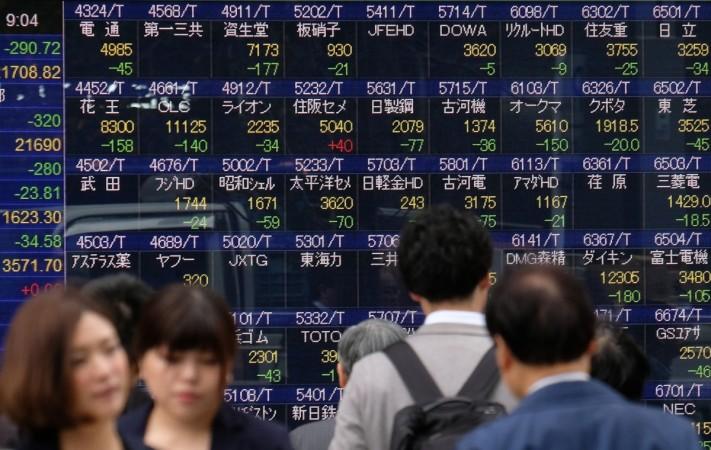
Asian share markets slumped on Tuesday as heightened concerns about a slowing global economy sent Wall Street stocks skidding to their lowest levels in more than a year.
MSCI's broadest index of Asia-Pacific shares outside Japan shed 0.3 percent in mid-morning trade while Japan's Nikkei tumbled 1.2 percent by the midday break.
Chinese shares opened in negative territory with the blue-chip index down 0.3 percent and Hong Kong's Hang Seng index flat, while Australian shares fell 0.8 percent.
MSCI's broadest gauge of the world's stock markets, ACWI, was down 0.05 percent on Tuesday, after having hit its weakest level since May 2017 the previous day. It has declined 16 percent from a top hit on Jan. 29.
U.S. stock futures rose 0.4 percent in Asia following the previous session's sharp sell-off.
On Monday, the S&P 500 lost 2.08 percent to hit its lowest since October 2017 as it breached lows reached during a sell-off in February, having wiped out about $3.4 trillion of market value since late September.
The Nasdaq Composite dropped 2.27 percent, with Amazon, one of the best performing shares this year, sliding 4.5 percent.
A profit warning from ASOS, a previously high-flying UK online-clothing retailer, shocked investors, sending U.S. consumer discretionary shares down 2.8 percent
"U.S. retailers have been stocking up consumer goods from China before hikes in tariff, piling up inventories. From now their costs are seen rising next year. That may have been kind of known to everyone but it's becoming reality," said Tatsushi Maeno, senior strategist at Okasan Asset Management.
In addition, the National Association of Home Builders Housing Market Index indicated U.S. homebuilder sentiment had fallen to a three-and-a-half-year low. It was the second consecutive month of disappointing reading.
The gloomy data came after weak economic news from China and Europe late last week.
The 10-year U.S. Treasuries yield dropped to 2.853 percent, edging near a Dec. 10 low of 2.825 percent, its lowest level since late August.
FOCUS SHIFTS TO FED
The Federal Reserve is widely expected to raise interest rates on Wednesday, which would be its fourth hike this year.
But many investors now expect signs of economic turbulence to prompt the Fed to signal a slowdown in the pace of tightening next year.
On Monday, U.S. President Donald Trump and his top trade adviser ratcheted up their criticism of the central bank's monetary tightening.
"It is incredible that with a very strong dollar and virtually no inflation, the outside world blowing up around us, Paris is burning and China way down, the Fed is even considering yet another interest rate hike. Take the Victory!" Trump wrote in a tweet.
White House trade adviser Peter Navarro amplified those remarks a few hours later, calling the Fed "crazy" for having signalled that it would continue to raise rates next year.
The Fed said in September that its policymakers see three more rate hikes in 2019 while money market futures are pricing in less than one such move.
"The major event between now and the end of the year is going to be what the Fed does tomorrow," said Jim McCafferty, Hong Kong-based head of Asia-ex-Japan equity research at Nomura.
"Given the pace of change of sentiment seen from not just companies but (also) from major macro-economies, I think there might be an outside chance that the Fed gives a more muted message in terms of growth and how aggressive it will be in terms of future rate hikes," he added.
The specter of a "dovish rate hike" kept the dollar in check.
The euro traded slightly higher at $1.1355, after having gained 0.40 percent on Monday.
The greenback gave up 0.1 percent against the Japanese yen to 112.70 yen, adding to Monday's fall of nearly half a percent.
The offshore Chinese yuan was slightly stronger at 6.8900 to the dollar.
Investors are awaiting details of a speech by President Xi Jinping to mark the 40th anniversary of China's market reforms.
China is also expected to hold its annual Central Economic Work Conference later this week, where key growth targets and policy goals for 2019 will be discussed.
Oil prices extended losses on signs of oversupply in the United States and as investor sentiment remained under pressure from concern over global economic growth and fuel demand.
U.S. crude fell as low as $49.01 per barrel on Monday, its lowest since September last year and last stood at $49.37, down 1.0 percent on the day.
Brent crude oil futures lost 65 cents, or 1.1 percent, to $58.96 per barrel.








